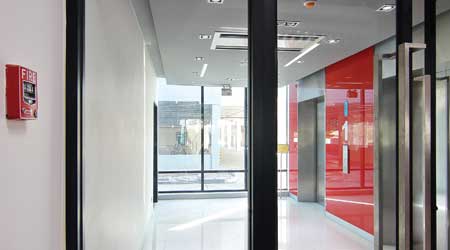 Fire safety system design must address critical interconnected emergency control equipment and wiring to fans, dampers, smoke control equipment, and elevators.
Fire safety system design must address critical interconnected emergency control equipment and wiring to fans, dampers, smoke control equipment, and elevators.How to Plan for Fire Alarm System Replacement
Success in fire safety system replacement planning requires a commitment from all stakeholders, including verification that the goals are the same as when the original system was installed.
If your plan is a total fire alarm system replacement, you need to have a solid replacement plan. A huge part of that plan will be an analysis of what system manufacturers will be considered. Are you only replacing one system or several systems in a number of buildings? Have you already standardized on a manufacturer or do you need to consider how various system manufacturers will be able to report or work together? What networking infrastructure do you need to consider?
Success in replacement planning requires a commitment from all stakeholders, including verification that the goals are the same as when the original system was installed. These goals include life safety, property protection, reliability, equipment standardization, and operational cost. Building owners and facility managers will want to make sure that their goals are met, including verifying that the system meets all minimum codes, that it provides long-term operational reliability, and that the equipment life cycle is sufficiently long to avoid more recurring costs. Unfortunately, there is often a focus only on the initial outlay of costs; not enough attention is paid to the long-term operational costs or modern technological improvements that could reduce long-term maintenance costs. This is where the audit described earlier can really come in handy: It provides a way of discussing the reality of your situation and what viable options exist. Providing a quality fire alarm replacement plan always involves balancing risk and cost and using the best fire alarm system alternative to mitigate the risk.
Often an alarm installer or electrical contractor will recommend using the existing wiring infrastructure for the new system. That is the most economical approach, but there are traps that could be costly or could result in unreliable system installations. One trap is that the reliability of the existing wiring is unknown. There may be t-taps or star-taps on the existing wiring that may affect system performance, especially if a different system manufacturer is selected for the replacement. Additionally, if the system audit revealed that the existing system does not meet current visual notification, audibility, or intelligibility requirements, a larger quantity of notification appliances will be required and that will most certainly have an effect on what wiring can be reused. The choice between existing or new wiring must be a big part of the replacement plan.
In your replacement plan, you should review your needs for emergency communication. It is possible that your facility does not require an emergency voice/alarm communications system (EVACS) but providing one may enable you to meet the modern threats the facility faces. If you already have an EVACS, can you supplement the system with additional emergency messages? If so, how will you decide what risks should be addressed by specific emergency messages? Or do you need additional emergency detection inputs for things like severe weather, shot detection, or hostile intruders? Replacing a fire alarm system provides an excellent opportunity to create or bolster your emergency communications or mass notification procedures.
Related Topics:














